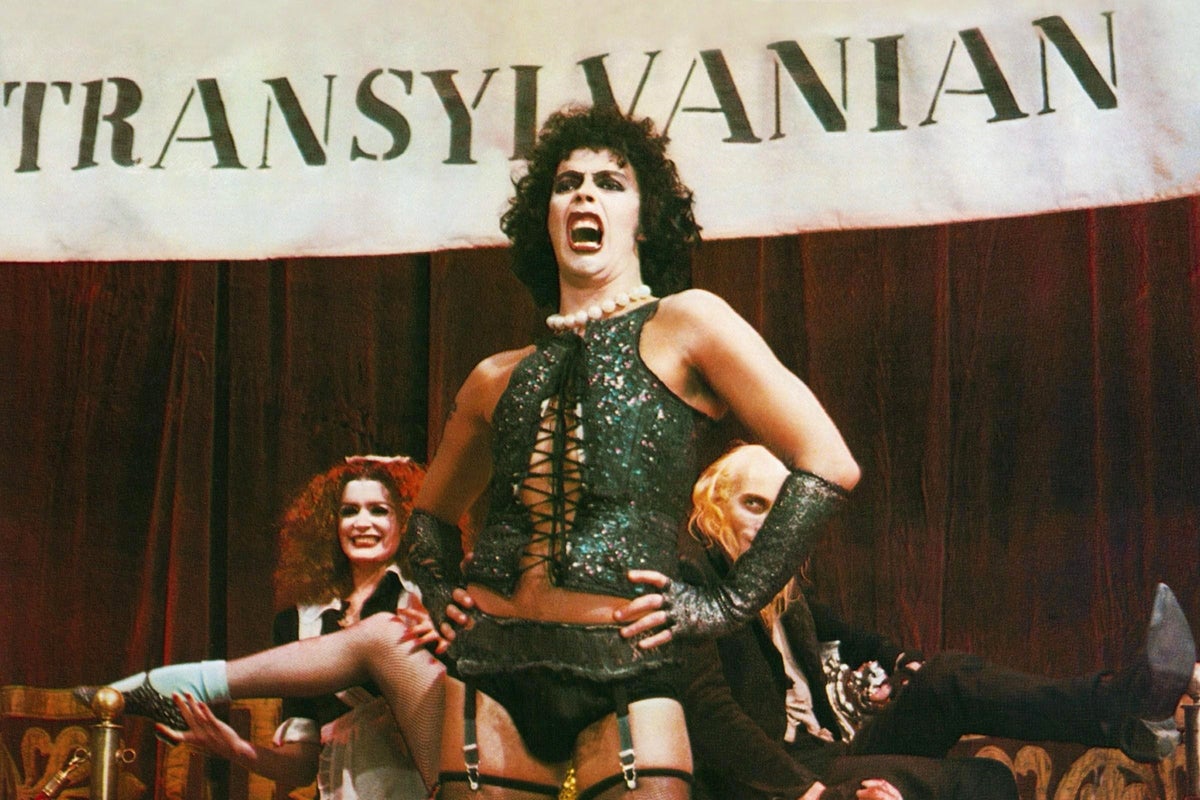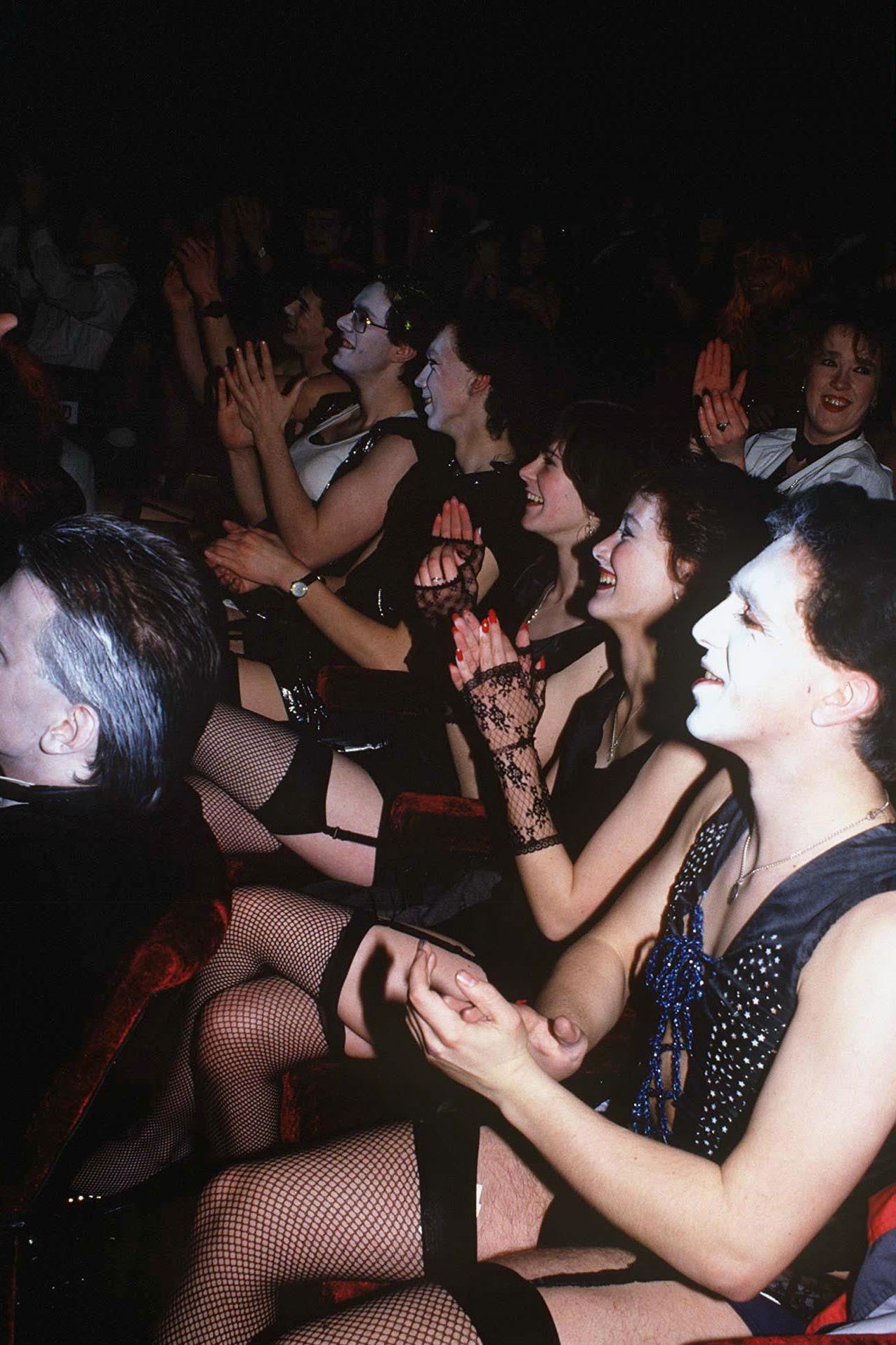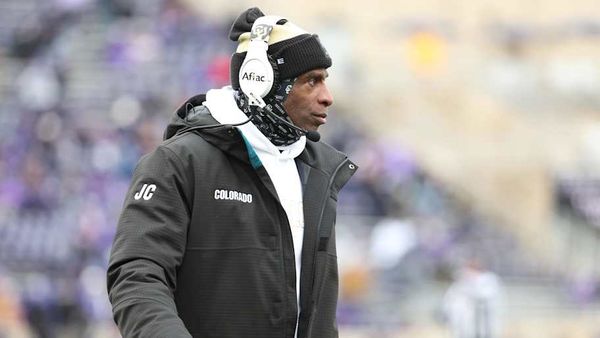
Picture this – you’re in a cinema, about to watch a movie called The Rocky Horror Picture Show. Suddenly, the audience starts heckling the actors on-screen, calling them bastards and s***s. Then rice and playing cards are thrown into the air around you. Before you know it, everyone’s on their feet dancing. Is there a gas leak in here? No. This is just another regular showing of the ultimate cult movie.
Best described as a musical valentine to pulpy sci-fi and horror movies of the Forties and Fifties, Rocky Horror began life on the London stage in 1973, its success fuelled by word-of-mouth and the sheer wildness of its premise: few bits of art begin with two upbeat suburbanites getting engaged at the beginning of the story, then winding up in an intergalactic bisexual pool orgy by its end.
Ask any Rocky Horror fan what the 1975 film adaptation is about and they’ll give you a different answer: exploring one’s sexuality, the need to express who you truly are, the importance of second-guessing whether or not to enter an ancient-looking Transylvanian castle. The white-hot engine of Rocky Horror is Dr Frank-N-Furter, a mad scientist clad in fishnets, pearl necklaces and baby pink latex gloves, who woos two all-American naifs (Barry Bostwick’s Brad and Susan Sarandon’s Janet) with his oozing sex appeal and devilish charm. As played by Tim Curry in a career-defining performance, Dr Frank-N-Furter is a machiavellian incubus by way of David Bowie.
Fifty years after its initial release, Rocky Horror has amassed global adoration, particularly on the midnight movie circuit. And no cinema in the world is more steeped in Rocky Horror’s rituals and traditions than the Clinton Street Theater in Portland, Oregon, which has shown the film every week without fail since 1978. “We’re certainly not a standard movie theatre,” co-owner Aaron Colter tells me.
Currently managed by a collective of six co-owners, including Colter, the 300-capacity Clinton Street Theater stands as one of the oldest continually operating cinemas in the United States. Since its opening in 1915, it has flirted with being a cinema block-booked by specific film studios and, later, an adults-only cinema. It was in 1975 that it began operating through shared ownership, with five free-spirited and like-minded film fans buying the space together, one of whom was Lenny Dee. “I thought people needed a model of a different kind of business to the one we currently had, and the ideas and passions media contains can be an important thing to present to people,” he remembers. “Those were my two driving forces.”
The film’s line ‘don’t dream it, be it’ just seems to unify everyone, but especially so many queer and trans people
Dee was the original booker of Rocky Horror, and thus technically the originator of the tradition. He first watched it as part of a programmed double bill with Phantom of the Paradise, Brian De Palma’s 1974 comedy-horror musical. “I actually liked that better than Rocky Horror, but I couldn’t get Phantom and wound up with Rocky Horror,” he remembers. “Then the fans kept coming.” That’s not to say Dee isn’t a fan of the movie; he estimates he’s seen it more than 300 times during his eight years of projecting it throughout the Seventies and Eighties.
It took time for Rocky Horror to take hold. The film initially sank like a stone upon release in 1975, with the critic Roger Ebert noting that “it was pretty much ignored by everyone”. Less than a year later, however, New York’s Waverly Theater decided to programme the film as a “midnight movie”, and it was there that schoolteachers Louis Farese Jr, Theresa Krakauskas and Amy Lazarus originated the props and audience interaction that would come to define the Rocky Horror cinema experience.
According to author J Hoberman’s book, Midnight Movies, on the cult film screening phenomenon, the first call-back line ever uttered at a Rocky Horror screening came as Sarandon’s Janet places a newspaper over her head to protect her from the rain. “Buy an umbrella, you cheap b****!” a punter apparently yelled from the audience. Speaking in 1982, Curry revealed that not only had he attended an audience-participation screening, but had in fact been thrown out due to accusations of being an imposter. “I thought it was enormous fun,” he said. “I was having a ball.”

These screenings slowly spread across the country, from New York to Los Angeles, San Francisco to Portland. Originally, the Clinton Street Theater programmed Rocky Horror in 1978 as one part of its revolving door of weekly repertory movies, but there was surprise at the turnout. Three weeks later, they trialled a full seven days of Rocky Horror screenings. “By then, we could feel something was happening,” Dee says. After moving it to a weekly midnight screening every Friday and Saturday, Portland was in the throes of Rocky Horror fever. By Halloween of 1979, more than 230 cinemas across the United States were screening twice-weekly midnight showings of the film.
The tradition has continued ever since, passed down from co-owner to co-owner, with Colter and company as the most recent joint custodians of the cinema. Colter mentions that they’ve had fans travel from as far as Germany just to see the film on their screen. “It’s become one of the things Portland is known for.”
The screenings have also become full-blown events. For neophytes, there are the semi-educational “Virgin Nights” hosted by local filmmaker Thom Hilton and drag performer Thee Countess Sinophilia. There, audiences are given cards teaching them what to say, when to say it, and when to throw their distributed props. For those fully acquainted with Rocky Horror lore, there are cabaret nights – one of which, named The Rocky Horror Lavender Show, is led by performance artist Marla Darling. “Everything we do is part of inviting the audience into the cult of Rocky Horror,” Darling explains. “[It’s] this feeling of entering an underground society of performers and artists that feels almost illicit.” These groups enact a “shadow cast” of the film, meaning a troupe performs in front of the screen itself, mimicking the actions and dialogue happening on-screen.
So why is it that The Rocky Horror Picture Show seems to have forged such a vast and global community of fans? For Dee, he feels the film is a progressive rallying call. “It promotes a different, more open way of being that pushes back against everything we’re seeing in the US right now from the current government,” he says. “I think that’s important to a lot of people.”

It’s a sentiment that’s echoed by Darling, who thinks that the film’s wholehearted queerness is more important than ever. “The film’s line ‘don’t dream it, be it’ just seems to unify everyone, but especially so many queer and trans people,” she tells me. “The idea that the person you see yourself [being] doesn’t have to just be a dream? As a queer person, that meant so much to me when I first heard it.” For Colter, he sees the effect Rocky Horror has on some of the cinema’s younger patrons – it’s as if they leave screenings with a weight lifted from their shoulders. “Being able to [provide a] safe space for them makes everything we do here worthwhile.”
Watching Rocky Horror in a packed and very loud cinema is also, arguably, the best way to see it, which is why so many still do. And it also speaks to the huge boom in repertory cinema of late, with younger cinemagoers flocking to emulate the original theatrical screenings experienced by their parents or grandparents. “I think there are a lot of movies that aren’t getting currency in the streaming universe, that a film-loving audience needs to go and see for themselves,” Dee says. “That’s really important – for people, for cinemas and for filmmakers.”
Whether it’s London’s The Nickel Cinema – which regularly sells out showings of exploitation fare including Brotherhood of Death and I Drink Your Blood – or the Prince Charles Cinema’s regular showings of the legendary so-bad-its-good thriller The Room, the communal, independent spirit spearheaded by Rocky Horror’s original revival screenings feels more alive than ever. Other cinemas that follow a similar business model to the Clinton Street Theatre have also screened films lately that have struggled to gain commercial distribution – notably the Oscar-winning documentary No Other Land, about Israeli occupation in Palestine. It’s just one of the many ways in which repertory cinemas and community-oriented efforts like the Clinton Street Theatre work not just to serve the people who attend, but to expand their understanding of the world around and beyond them.
For Dee, that’s all he wishes for the legacy of the Portland institution. “I’m thrilled people continue to see value in bringing everyone together as a community around film,” he tells me. “And I think that’s a value the people of Portland are going to continue to uphold for a very long time.”
The 20 most disastrous sex scenes in film, ranked
Alison Brie and Dave Franco: ‘It’s been scary divulging so much personal info lately’
11 on-screen romances that turned into off-screen marriages
21 fan theories that will completely change the way you watch these iconic films
‘I hate it’: 11 movies that actors regretted saying yes to
Dance with a Stranger at 40: Miranda Richardson on playing the UK’s last hanged woman







